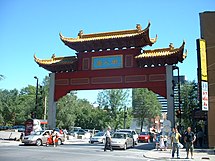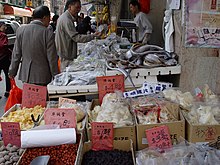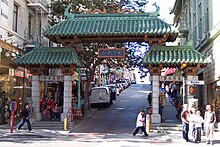Chinatown
| Chinatown | |
|---|---|
| One of three entrance gates to Chinatown (“Quartier chinois”) in Montréal , Canada | |
| Chinese name | |
| Long characters | 唐人街1 |
| Abbreviation | 唐人街 |
| Pinyin | Tángrén jiē |
| Jyutping | Tong 4 jan 4 gaai 1 |
| Alternative name | |
| Long characters | 中國 城2 |
| Abbreviation | 中国 城 |
| Pinyin | Zhōngguó chéng |
| Jyutping | Zong 1 gwok 3 sing 4 |
| Long characters | 華人 街1 |
| Abbreviation | 华人 街 |
| Pinyin | Huárén jiē |
| Jyutping | Waa 4 jan 4 gaai 1 |
| Japanese name | |
| Kanji | 中華 街3 |
| Kana | ち ゅ う か ・ が い |
| Hepburn | Chūka · gai |
| Alternative name | |
| Kanji | 南京 町4 |
| Kana | な ん き ん ・ ま ち |
| Hepburn | Nankin machi |
| Kana | チ ャ イ ナ ・ タ ウ ン |
| Kana | ち ゃ い な ・ た う ん |
| Hepburn | Chaina taun |
Chinatown ( Chinese 中國 城 / 中国 城 - "Chinese city , Chinese city") 2 describes districts outside of China in which predominantly people of Chinese descent live and work. The Chinese mostly choose the term "Tangren Jie" 1 ( 唐人街 - "Street of the people of the Tang period , analogous to Chinese street "), regionally also "Huaren Jie" 1 ( 華人 街 / straße 街 - "Chinese street ") or "Zhonghua Jie" 3 ( 中華 街 / 中华 街 - "Chinastaße, Chinese Straße").
In the past, the term had a negative sound, because in Chinatowns there were often hygienic and structural grievances. Chinatowns have been subject to a process of change for a long time. The assimilation of the Asian population in many countries leads to the gentrification of the formerly uniform city districts. Some of the Chinatowns in these countries are now popular tourist destinations, especially those with a long history.
Historical development
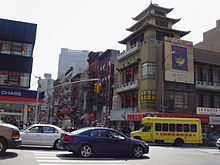
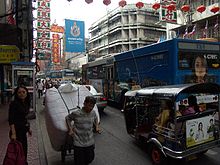
The oldest separate Chinese districts are Shinchimachi in Nagasaki ( Japan ), and Yaowarat Road in Bangkok ( Thailand ), which Chinese traders founded more than 200 years ago. The Chinatown in Melbourne ( Melbourne Chinatown ) was established in 1854 during the Victorian Gold Rush and is the longest continuous Chinatown outside of Asia.
Immigration from China to other parts of the world accelerated in the 1860s with the entry into force of the Beijing Convention . The first immigrants came mainly from the coastal provinces of Guangdong and Fujian - where Cantonese , Min (e.g. Minnan language such as Hokkien , Teochew ) and Hakka are mainly spoken - in southeastern China. At first, the Qing government of China did not care about this migration of social loners who left the country. They were viewed as socially undesirable and as traitors to China.
Chinese from Guangdong (Cantonese), in particular from the Taishan (Taischanese) and Guangzhou (Canton) area, first founded Chinatowns in North America ( USA , Canada ), Australia and Latin America ( Cuba , Mexico and Peru ). The American sociologist Min Zhou goes so far as to regard the western Chinatowns as a genuinely American invention. In contrast to the classic immigrant districts, for example in the consideration of Robert Ezra Parks , Chinatowns have not become transition stations to the American melting pot , but instead occupy and retain a permanent economic and sociological special position.
Cantonese remained the leading language and was the legacy of many Chinatowns in the western states well into the 1970s. Seen as a group, the Cantonese are linguistically and ethnically different from other groups in China, in contrast to migrants who mainly come from the Siyi and Sanyi regions ( 四 邑 三 邑 地區 / 四 邑 三 邑 地区 ), i.e. the Jiangmen region, such as B. Taishan, Heshan , Kaiping , Xinhui , where different variations of Cantonese are spoken. As a result of laws in some countries, particularly the United States, where immigration of Chinese wives was not allowed due to the alleged Yellow Danger , Chinatowns became a place where men dominated and the male-to-women ratio was generally skewed . In Latin America, the Cantonese-speaking migrants came mainly as coolies for wages and bread. They were mainly used in Peru on the guano fields and in Cuba on the sugar plantations , which resulted in state-supported Chinatowns.
The Hokkien and Teochew (both groups who speak the Minnan subgroup of Chinese dialects), along with the Cantonese, are the dominant groups in Southeast Asian Chinatowns such as Kuala Lumpur , Malaysia . The Hakka established Chinatowns in Africa , for example on Mauritius , in Latin America and in the Caribbean . Chinese from the north settled in Korea in the 1940s. In Europe, the first Chinese were seafarers and dock workers . Because of this, the first Chinatowns were there in the port cities, such as Amsterdam in the Netherlands , Hamburg in Germany or Liverpool in Great Britain . France received most of the first Chinese immigrant workers, mainly from Wenzhou . There are also Chinatowns in Indian cities, such as Calcutta and Mumbai .
Since the mid-1970s, a process began in Chinatowns that led to significant changes, gentrification and increased tourist attractiveness in the affected districts. Immigrants from other parts of the Asian region move to the Chinese neighborhoods and result in a mix of Asian ethnic groups . Events like the Vietnam War reinforced this tendency. The Chinese majority population increasingly switched to a pan-Asian total population, whereby the character limited to Chinese exiles is partially lost.
Towards the end of the 20th century, the number of Chinatowns established dropped sharply. Chinatowns in Las Vegas (1990) and Seoul (2005) are the most recent major startups.
- annotation
Characteristic
Historic Chinatowns with large entrance gates ( Paifang ), which were built on the access roads, as well as buildings and temples in traditional Chinese architecture are considered to be the typical appearance of a Chinatown. Most Chinatowns are the result of chaotic development - only rarely, as in Seoul, are districts planned. Traditionally, they have a high population density and are socially, culturally and partially economically self-sufficient from the rest of the city . Traditions such as the Chinese New Year celebrations , but also language and religions, will continue unchanged. In some cities, bilingual traffic signs have even been introduced in Chinatowns. Asian restaurants, snack bars, shops and small industries dominate. The informal sector is an important industry.
The social conditions are fundamentally different in the individual cities, regions and continents. Nowadays, increasing assimilation is causing many neighborhoods to lose their uniformly Chinese characteristics and population and gradually gentrification takes place. Some Chinatowns have developed into modern neighborhoods with fully developed infrastructure and strong economies. At the same time, there are many poor Chinatowns that are suffering from devastating grievances. Tourism has significantly improved the quality of life in the districts in many places. However, it also leads to the falsification and artificial exaggeration of the Asian accents.
Chinatowns worldwide
Europe
Belgium
In Belgium there are currently three Chinatowns in Brussels and the port city of Antwerp . The Brussels Chinatown was located between the stock exchange and the Place Sainte-Catherine .
Germany
In Germany, there is an increased concentration of Chinese businesses and residents in the western part of Berlin , especially around Charlottenburger Kantstrasse .
In Hamburg , there were up to the eviction and deportation by the Nazis in May 1944, the small hamburger Chinatown in St. Pauli . The reconstruction of a local Chinatown is planned. Hamburg maintains close relations with the People's Republic of China - the important German-Chinese economic summit " Hamburg Summit " is held here every two years . Moreover, it is Shanghai 's sister city of Hamburg. The Chinese Consulate General is located at Elbchaussee 268 in Hamburg-Othmarschen .
See also: Chinese in Germany
France
Paris boasts “the largest Chinatown” ( le plus grand quartier chinois ) in Europe. Located in the 13th arrondissement , the Asian quarter consists of Chinese, Vietnamese and Laotian merchants and residents. The area runs between Avenue d'Ivry and Avenue de Choisy, east of Rue de Tolbiac. This area is often referred to as Chinatown by the residents of Paris , although the majority of the residents are actually from the former French colonies of Southeast Asia ( French Indochina ). In addition to the large Chinatown in the 13th arrondissement, there are two smaller Asian quarters:
- In the third arrondissement , around the Rue des Gravilliers , there are many Asian wholesalers (fabrics, bags, clothes, jewelry), which is why this district is also called Sentier chinois (named after the center of the Parisian clothing industry, Sentier in the second arrondissement ). It is the oldest Chinatown in Paris.
- In the Belleville district in the 19th arrondissement , which is shaped by many different cultures, there is another Chinese quarter.
Great Britain
The London Chinatown is in the district of Soho . Manchester also has an important Chinatown. Newcastle upon Tyne , Birmingham and Liverpool also have Chinatowns.

Italy
Italy has a rapidly growing Chinese minority. The country had had a small Chinese minority since World War II , but most of the current Chinese population did not enter the country until the 1980s. An estimated 60,000 to 100,000 Chinese lived in Italy in 2005.
Rome has a few small Chinatown districts; the fastest growing Roman Chinatown is in Esquilino .
Milan's Chinatown is located around Via Paolo Sarpi .
Prato's Chinatown is the largest in Italy. Many first generation immigrants work in the clothing industry. The Italian name for Chinatown is quartiere cinese , the English name Chinatown is also often used.
In Trieste , a small Chinatown has emerged north of the Grand Canal.
Netherlands
Chinatown in Amsterdam is the oldest Chinese neighborhood on mainland Europe. In 2010 the district celebrated its 100th anniversary.
There is also a Chinatown in The Hague . The former Jewish quarter there was largely empty and shabby after the Second World War. In the seventies of the twentieth century, the community decided to renovate the neighborhood, from then on more and more Chinese settled there.
Austria
In Vienna there is a Chinese Grätzl (little Chinatown) along the Naschmarkt, between Karlsplatz and Kettenbrückengasse. A large part of the Asian shops and businesses are concentrated there. Around 300 Chinese restaurants with more or less authentic cuisine can be found all over the city.
Serbia
The largest Chinatown is in the newer part of Belgrade . Many Chinese traders can also be found in Novi Pazar . Serbian Chinatowns don't have a specific name; the normal name is kinezi .
Hungary
In 1994, the largest Asian market in Budapest was opened on the approximately 26 hectare site of MÁV, the Hungarian railway company that is still the owner. At the beginning of the 1990s, thousands of Chinese settled here in Józsefváros (Josefstadt), who poured into the country after 1988. During this time, at a routine consular conference, the Hungarian side made the proposal to abolish the visa requirement between the countries, since these are two "friend states" with hardly any tourist or official delegation contacts.
Asia
Japan
The oldest Chinatown is that of Nagasaki , which dates back to the 17th century. The other Chinatowns, v. a. in Yokohama and Kobe , emerged after the opening of the port of Japan, when foreigners were only allowed to settle in certain assigned areas of the treaty ports.
Singapore
There is also a Chinatown in the multi-ethnic city-state of Singapore .
Thailand
The most famous Chinatown in Thailand is the one in the capital Bangkok . The Samphanthawong district forms a large collection of shops along Yaowarat Road , New Road ( Thanon Charoen Krung ) and Sampheng Lane (today: Soi Wanit 1), especially for gold and jewelry as well as fish restaurants in the evening. The proportion of people of Chinese descent in the total population of Thailand is about 10-15%. The province with the largest proportion of Chinese is said to be Chanthaburi , about 180 kilometers east of Bangkok.
Australia and Oceania
Australia
Well-known Chinatowns are in Sydney, Melbourne and Broome. But there are also small Chinatowns in Darwin , Adelaide and other larger cities.
Nauru
The island state of Nauru has a Chinatown on Aiue Boulevard in Aiwo .
Middle and South America
Peru
Peru has an above-average proportion of the population of Chinese origin, around 300,000 people, mostly from Guangdong . Most of them live in the capital, Lima . The Chinatown in Lima is known as Barrio Chino and is located to the east of the historic city center in the Barrios Altos district . The landmark of this district is the Chinese archway, which is followed by a pedestrian zone with Chinese shops and restaurants.
Chinese cuisine went through a special development in Peru, which, in contrast to the typical Chinese meals that are used worldwide, experienced a strong mix with the existing Peruvian cuisine and produced various new dishes. This cuisine is known under the name Chifa and is now an integral part of Peruvian gastronomy. Visitors to Lima are recommended to go to an appropriate Chifa restaurant.
Cuba
The Barrio Chino of Havana is centrally located near the Capitol around Calle Dragones. Although it is still characterized by an archway and a few Chinese restaurants, it is no longer a particularly Chinese-influenced residential area.
See also:
North America
In the rich countries of North America, the majority of the Chinese have achieved a high degree of social integration and, as a rule, have also reached the middle class. The Chinatowns, which are always in the centers of large cities, have lost their attractiveness as residential areas due to a lack of space and the rise in property prices; Chinese families have preferred to settle in the suburbs since the 1950s. With their infrastructure of shops, restaurants, cultural institutions and churches, the Chinatowns are still the centers of social life for the North American Chinese to this day.
Canada
In Canada , the Chinese are the largest visible ethnic minority. There are significant Chinatowns in Vancouver , Toronto and Montréal , among others .
United States
The first major Sino-American wave of immigration took place during the Californian gold rush (since 1848). The first Chinatown on North American soil was built in the port city of San Francisco , where the majority of Chinese migrants entered. As sojourners (German: 'guest workers'), they almost always came without their wives and children, who they supported with money transfers from America. From the outset, the Chinese were exposed to considerable xenophobia, which led to mass displacement during the economic downturn in the 1870s and culminated in the passage of the Chinese Exclusion Act in 1882, which banned Chinese immigration for more than 60 years. This development coincided with the displacement of Chinese workers from many economic sectors (agriculture, fishing, light industry) and their spatial segregation : after the Chinese migrants had lived and worked all over the American West, they withdrew - often under legal compulsion - back to the Chinatowns. In search of employment opportunities, many went to the big cities in the eastern United States, where Chinatowns had now also sprung up. Segregation did not end until the second half of the 20th century, after the immigration laws were gradually liberalized from 1943 to 1965, larger numbers of Chinese women were able to enter, and Chinese migrants were given the first opportunity to acquire American citizenship . The Chinatown of New York City with around 666,000 inhabitants is now the largest Chinese settlement outside of Asia. At the same time, a broad Sino-American middle class emerged with a high level of education and an equally high level of social and cultural assimilation. The majority of Chinese Americans now live in residential areas, such as those preferred by the non-Asian middle class, such as the suburbs of large cities. The Chinatowns with their oppressed and unfashionable living conditions now only offer accommodation to a small minority of Chinese who often do not speak English - including many poor old people. In addition, the Chinatowns - with their infrastructure of shops, restaurants, churches, theaters, cinemas, etc. - serve the Sino-American community as an economic, cultural and social center, which Chinese people who live in the suburbs also regularly visit. The Chinatowns have always played a role as tourist attractions .
Chinatowns in the USA can be found in Honolulu , San Francisco , Oakland , Los Angeles , Stockton , Portland , Seattle , Houston , Chicago , Philadelphia , New York City , Boston , Baltimore , Washington, D. C. , among others . Some Chinatowns in the US have been abandoned in the last hundred years, such as the Chinese Quarter in Sacramento , San Diego , St. Louis , Cleveland , Pittsburgh or Oklahoma City .
See also:
- History of the Chinese in the United States
- History of the Chinese in Hawaii
- Chinatown (San Francisco)
Africa
Morocco
The fastest growing Chinatown in Arabic-speaking North Africa is Quartier chinois in the Derb-Oma district of Casablanca . Many residents of this Chinatown work in textile wholesaling.
South Africa
Johannesburg has an old Chinatown on Commissioner Street. A newer Chinatown can be found in the suburb of Cyrildene on Derrick Avenue.
literature
- Yuanchen Zhang: Cinematic Chinatown. Space, Narration and Representation '. Tectum , Marburg 2012, ISBN 978-3-8288-2891-9 ( full text in the Google book search).
See also
Web links
Individual evidence
- ↑ a b Min Zhou : Chinatown. The Socioeconomic Potential of an Urban Enclave (= Conflicts in Urban and Regional Development ). Temple University Press, Philadelphia PA 1995, ISBN 1-56639-337-X .
- ↑ term Tangren -唐人. In: www.zdic.net. Retrieved April 5, 2020 (Chinese, German, French).
- ↑ term Tangren -唐人. In: leo.org . Retrieved April 5, 2020 .
- ↑ term Tangren -華人/华人. In: www.zdic.net. Retrieved April 5, 2020 (Chinese, English).
- ↑ term Tangren -華人/华人. In: leo.org . Retrieved April 5, 2020 .
- ↑ Term Zhongguoren - 中國 人 / 中国 人. In: www.zdic.net. Retrieved April 5, 2020 (Chinese, English).
- ↑ Term Zhongguoren - 中國 人 / 中国 人. In: leo.org . Retrieved April 5, 2020 .
- ↑ Chinese Charlottenburg: Berlin's Chinatown in the West , Tagesspiegel, June 17, 2013
- ↑ The End of Hamburg's Chinatown , Deutsche Welle, accessed on May 14, 2019
- ↑ Hamburg Summit: China wants to be the solution , Berliner Tagesspiegel, October 11, 2014
- ↑ Chinatown The Hague. www.denhaag-holland.de, accessed on January 10, 2019 .
- ↑ pesterlloyd
- ↑ Chinese in Budapest brandeins.de. Retrieved November 10, 2017
